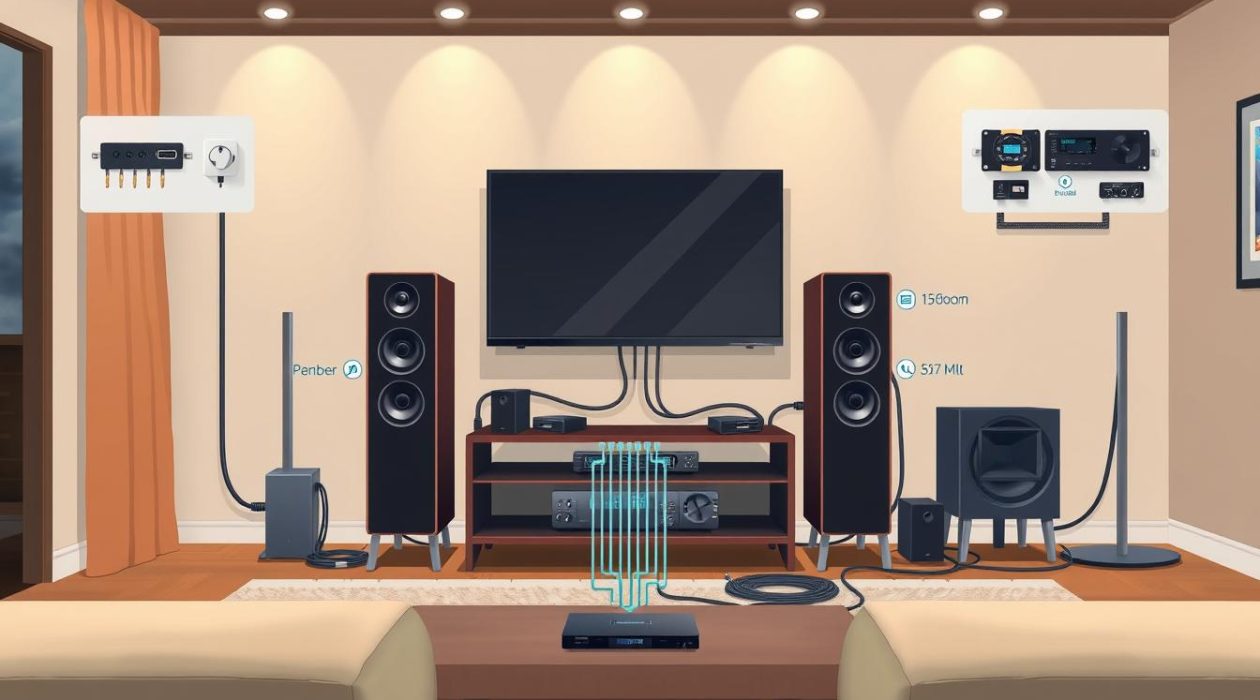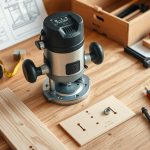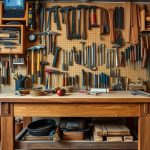Creating a great home theater needs careful planning and attention to detail. This is true for entertainment wiring and AV setup. It’s important to manage power and cables well to ensure a top-notch entertainment experience. Knowing how much power you need is key to avoid overloads and keep things safe.
A well-thought-out entertainment system with good power and cable management can make watching movies or playing games better.
A home theater has many parts, like TVs, sound systems, and gaming consoles. Each needs its own power. Planning how to distribute power and manage cables is vital for a reliable and efficient system. By focusing on entertainment wiring and AV setup, homeowners can make a space that’s just right for them and offers a deep experience.
Introduction to Home Theater Electrical Guide
As more people want better home entertainment, focusing on power and cable management is key. Knowing what to consider and what parts are involved in setting up a home theater helps homeowners make smart choices. This way, they can build a system that fits their needs and offers a great experience.
Key Takeaways
- Proper power and cable management are crucial for a high-quality home theater experience
- Understanding power requirements is essential to avoid overload and ensure safety
- Entertainment wiring and AV setup require careful planning and attention to detail
- A well-designed entertainment system can enhance the overall viewing experience
- Homeowners should consider power distribution and cable management when creating a home theater setup
- Customized entertainment spaces can provide an immersive experience with proper power and cable management
Understanding Home Theater Power Requirements
Setting up a home theater means looking at the power needs of your gear. Knowing what your system needs is key for a good setup. The power needs vary based on the devices you have, like your TV, sound system, and more.
To figure out your system’s total power needs, add up the wattage of each device. You can find this info in the manual or on the manufacturer’s website. This way, you can know how much power your system will need.
Calculating Total Power Needs
Figuring out your system’s total power needs is easy. Just add up the wattage of each device. Don’t forget to include any extra power needs, like for lights or accessories. Also, make sure your home’s electrical system can handle the power of your home theater.
Circuit Capacity Planning
After figuring out your system’s total power needs, think about your home’s electrical system. This will tell you if you need to upgrade or add new circuits for your home theater. Planning your circuit capacity well ensures your system works smoothly.
Surge Protection Essentials
Don’t forget about surge protection for your home theater gear. Power surges can harm your equipment and cost a lot to fix. Using surge protectors or power conditioners can keep your gear safe and running well.
Understanding your home theater’s power needs and planning well can give you a reliable setup. Remember to consider each device’s power needs, calculate your system’s total power, and plan your circuit capacity. This way, you’ll have a great viewing experience.
| Device | Wattage |
|---|---|
| TV | 200W |
| Soundbar | 100W |
| Other devices | 50W |
| Total power needs | 350W |
Audio/Video Wiring Fundamentals
Setting up a home theater system requires proper cable routing. This ensures top performance and keeps things tidy. It’s all about planning your cable layout to avoid tangles and kinks. These can mess up your signal quality.
Good wire organization keeps your space clean and safe. It lowers the risk of electrical dangers. Plus, it makes fixing problems easier.
Understanding your cables and connectors is key. Home theaters use HDMI, optical, and coaxial cables. Each has its own role and benefits. Choosing the right cables means better connections and quality sound and video.
- Labeling cables to identify their purpose and destination
- Using cable ties or clips to secure cables and keep them organized
- Avoiding tight bends or kinks in cables, which can damage the insulation and compromise signal quality
- Keeping cables away from power sources and other potential sources of interference
By following these tips, you can set up a home theater that works well. It will meet your needs and give you a great viewing experience.
Planning Your Entertainment Space Layout
When designing your home theater, think about the layout of your entertainment space. A well-planned room can greatly improve your viewing experience. It’s important to consider where to place your equipment for both looks and function.
When planning your room, consider the layout. Think about doors, windows, and any obstacles that might affect your equipment’s placement. This way, you can make a layout that looks good and works well.
Room Configuration Considerations
When planning your room, consider its size and shape. Think about where to put seating and your equipment like speakers and screens. Also, think about how people will move around the room and how it will affect your viewing experience.
Equipment Placement Strategy
Having a good plan for where to put your equipment is key. Think about where to put DVD players, gaming consoles, and sound systems. By placing them in easy-to-reach spots, you make your system simple to use and maintain.
Access Point Planning
Don’t forget about access points when designing your space. Think about where to put outlets, USB ports, and other connection points. By placing these in smart spots, you make your system easy to use.
- Consider the room’s configuration and how it will impact equipment placement
- Plan for a clean installation by thinking about the flow of traffic in the room
- Place components in a logical and accessible location
By following these tips, you can make an entertainment space that’s both useful and fun.
Essential Power Distribution Solutions
Setting up a home theater system requires meeting your equipment’s power needs. Proper power distribution ensures your devices get the power they need to work well. You’ll need power conditioners and surge protectors for this.
These devices are key in managing power flow to your equipment. They protect against voltage spikes and other electrical issues. Choosing the right solutions helps your home theater system run smoothly, giving you a great entertainment experience.
When picking power distribution solutions, consider a few things:
- Calculate your equipment’s total power needs.
- Find a power conditioner that meets those needs.
- Choose a surge protector that protects your devices well.
Investing in the right power distribution solutions is crucial for a reliable home theater experience.
Think about your home theater’s design and layout when choosing solutions. Plan where your equipment goes and make sure your power devices are easy to reach. This setup ensures a seamless and enjoyable entertainment experience that meets your power and equipment needs.
| Power Distribution Solution | Description | Benefits |
|---|---|---|
| Power Conditioner | Regulates voltage and filters out noise | Protects equipment from damage, improves sound and image quality |
| Surge Protector | Protects equipment from voltage spikes and surges | Prevents equipment damage, reduces risk of electrical shock |
Cable Management Systems and Methods
Effective cable management is key for a clean home theater system. It makes the room look better and keeps cables and equipment safe. Cable routing and wire organization are vital to keep cables hidden and secure.
There are many ways to manage cables. In-wall cable routing hides cables behind walls and baseboards. This method needs careful planning and execution. External cable organization uses cable ties and clips to manage cables outside walls.
In-wall Cable Routing
In-wall cable routing keeps cables hidden. It involves running cables through walls and ceilings with special tools. This method requires careful planning and execution, as it involves drilling holes and running cables through tight spaces.
External Cable Organization
External cable organization is simpler and cheaper. It uses cable ties, clips, and other accessories to manage cables outside walls. This method is great when in-wall routing is not possible or practical.
Decorative Concealment Options
Decorative concealment options hide cables in a stylish way. Options include cable covers, cord concealers, and decorative cable ties. They come in various colors and styles, matching the room’s decor easily.
Using cable routing and wire organization methods makes a home theater system clean and organized. Whether you choose in-wall or external cable organization, careful planning and precision are key.
Signal Quality and Interference Prevention
To get the best entertainment experience, you need to focus on signal quality and preventing interference. Good entertainment wiring is key to avoiding interference and keeping signals strong. Think about the devices you’ll use and how they might affect your signal quality when setting up your AV system.
Interference can come from electromagnetic interference (EMI) and radio-frequency interference (RFI). To fight these, use top-notch entertainment wiring and keep devices apart. You can also use shielding or filters to cut down on interference.
Here are some tips to avoid interference in your AV setup:
- Use high-quality entertainment wiring to minimize signal degradation
- Keep devices away from each other to reduce EMI and RFI
- Use shielding or filtering to reduce interference
- Regularly inspect and maintain your entertainment wiring to prevent damage or degradation
By following these tips, you can ensure your AV setup has great signal quality and avoids interference. Always choose high-quality entertainment wiring and take steps to reduce interference.
With careful planning and attention to detail, you can make an AV setup that offers a top-notch entertainment experience. Remember to think about signal quality and interference prevention when setting up your AV system.
| Interference Type | Description | Prevention Method |
|---|---|---|
| Electromagnetic Interference (EMI) | Interference caused by electromagnetic fields | Use shielding or filtering |
| Radio-Frequency Interference (RFI) | Interference caused by radio-frequency signals | Use shielding or filtering |
Professional Installation vs DIY Considerations
Choosing between a professional or DIY installation for your home theater is key. A clean installation is vital for the system’s proper function and safety. It requires careful planning and attention to equipment power needs.
Here are some points to think about:
- Cost: Professional setup might cost more but can be safer and more efficient.
- Tools and skills: DIY needs special tools and tech knowledge, which can be hard without experience.
- Safety: A pro installation considers safety, like surge protection and correct wiring.
A clean installation looks good and prevents equipment power and signal issues. Weighing these points helps decide between a pro or DIY setup.
For a great home theater, planning and detail are crucial. Whether you go pro or DIY, focus on a clean installation and equipment power management for the best viewing.
| Installation Type | Cost | Tools and Skills | Safety |
|---|---|---|---|
| Professional | Higher | Specialized | Ensured |
| DIY | Lower | Basic | Variable |
Troubleshooting Common Wiring Issues
Home theater systems need good cable routing and wire organization for the best performance. But, problems can happen, ruining your viewing and listening experience. Here are some steps to fix common wiring issues:
Issues like bad picture quality, distorted sound, and system crashes are common. These problems often come from bad cable routing or wire organization. Finding and fixing the main problem is key.
- Check for loose connections and secure them properly
- Verify that all cables are properly routed and organized
- Ensure that all devices are properly configured and connected
By following these tips, you can fix common wiring problems. This ensures your home theater works smoothly, giving you a great viewing and listening experience.
Proper wiring and cable management are essential for a high-quality home theater system. By taking the time to troubleshoot and resolve common wiring issues, you can ensure optimal performance and enjoy your favorite movies and shows without interruption.
Future-Proofing Your Setup
Creating a home theater system means thinking ahead. A good AV setup and wiring make your system last for years. They keep it relevant and working well.
Here are key things to consider:
- Expandability options: leave room for upgrades and new devices
- Smart home integration: seamlessly connect your home theater to other smart devices
- Emerging technologies: stay up-to-date with the latest advancements in AV technology
By focusing on these areas, your home theater will be great today and ready for tomorrow’s tech.
Expandability Options
It’s important to have room for future upgrades. Use modular parts and flexible wiring for this.
Smart Home Integration
Smart home tech lets you control your theater and other devices easily. It makes watching movies better and more convenient.
Emerging Technologies
Keeping up with new AV tech lets you enjoy the latest features. This includes better sound and picture quality.
Conclusion: Creating Your Perfect Home Theater Setup
Creating the perfect home theater setup is all about paying attention to power needs, managing equipment power, and keeping cables tidy. By planning your power needs well, organizing your wiring, and using smart cable management, you can make your entertainment system seamless. This will give you an immersive experience in watching and listening.
Understanding your power requirements, managing your equipment power well, and having a clean installation are key. By following the tips in this guide, you can turn your living space into a movie paradise. It will amaze your senses and impress your guests.
With the right planning, tools, and focus on details, you can take your home entertainment to the next level. Let your love for entertainment lead you to the perfect setup. It will make your movie nights and gaming sessions unforgettable.


